
Yellow leaves? Brown spots or dots on your weed leaf? These kinds of leaf problems are more common than you think. They are also often easy to prevent by simply buying the right plant food. But what do you do if you already have the problem? In this article, we are going to point by point solve the most common leaf problems for you, so that your plant will be healthy again and your yield will be secured. Written for beginners, but if you follow the links, you'll learn a lot more about growing weed plants. So you'll become a weed expert at Dutch-Headshop in just a few articles.
Plant hanging limp
Probable cause
Too much water, too little water or a severe nutrient deficiency.
Continue to investigate and fix leaf problems
Too much water: check if the leaves also feel heavy and thick. If so, the plant probably has too much water. The longer your weed plant receives too much water, the more yellow the leaves will turn. So if your leaves are also yellow ánd they hang limp ánd they feel thick, then you can be sure she is getting too much water.
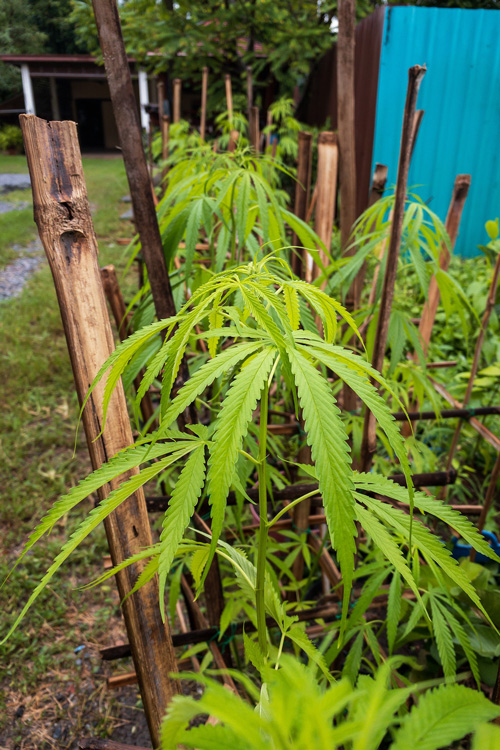
- Only water your weed plants if your finger does not get damp when you stick it one notch deep into the soil next to your weed plant.
- Provide adequate drainage. Make holes at the bottom of the pot, don't press the soil and use clay pellets at the bottom of the pot so excess water can leave and the roots can air out.
Not enough water: the leaves will also droop if your weed plants don't get enough water. Check if the leaf feels like dry newspaper. Usually the leaf also looks grayish/colorless. In any case, the leaf is not yellow. Brown is possible, in which case it is unfortunately too late.
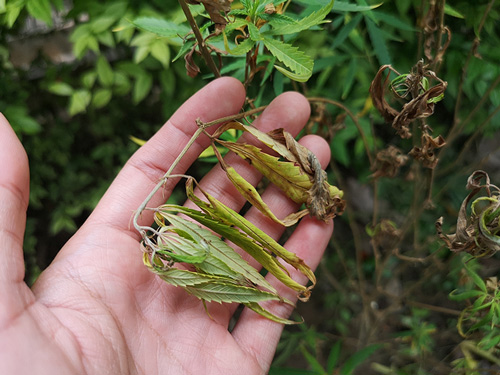
- Weed plants love water, as long as excess water can drain away. Fortunately, extra watering is easy. Water generously when the above symptoms occur.
- Double check that the leaves are not puffy and yellow and stick your finger a notch deep into the soil. Remove your finger from the soil and look at your finger. Is there no soil sticking to it? Does it feel dry and barren? Water quickly. On the other hand, is the soil soaking wet? Then check the other symptoms in this article; something else might be going on.
Severe nutrient deficiency: do the leaves hang limp, but don't feel thick? Are the weed leaves discolored, have spots, holes or other distressing features? That probably indicates a nutrient deficiency.
- Water is not the only thing a weed plant needs to survive. Your plant also needs the right nutrition and the right amount of nutrients. Read all about giving weed the right nutrition.
Yellow Leaf Weed Plant
Probable cause
Nitrogen deficiency. Other possible causes: too much water, pH incorrect, cold weather, heat, mold or root rot.
Continue to investigate and fix leaf problems
Nitrogen deficiency: nitrogen deficiency is the most common form of malnutrition in weed plants. If a nitrogen deficiency is the problem, the leaves will slowly but surely turn yellow; from the outside inwards.
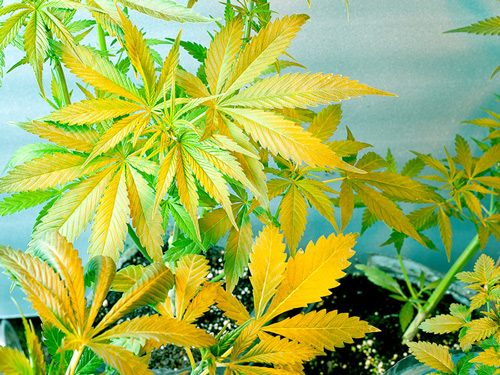
- If you have ruled out that too much water is not the problem and the ambient temperature is OK, then you can move on to givingthe correct weed plant nutrition.
- Do not give too much nutrition at once. That's a common mistake that causes the problem to turn the other way. Just give according to the growing schedule and give at every watering. Want to go a step further and give exactly the amount of nutrients needed? Then also check the EC value before giving nutrition.
- It is common for the lowest bracts to turn yellow first. This is no immediate cause for alarm. As long as the whole plant does not turn yellow, you do not need to give extra plant nutrition right away.
Other possible causes of yellow leaves
If the pH-value is out of balance, one of the symptoms may be that the leaves turn yellow. In soil, you have a little more wiggle room in the pH and water balance than when growing in coco, for example. Above we wrote that too much water can also be a possibility. Check the problems above about too much water and below about too much nutrition or overheating. Another possible cause can be checked this way. Check the bottom of the leaf for gray or white clusters of lint sticking to the leaf. That’s downy mildew that causes leaf spot disease. This fungus sucks nutrients directly from the leaf like a parasite, causing you to see first yellow and later brown spots on the top. You can combat downy mildew, for example, with natural neem oil.
Yellow and Brown Discoloration and Curled Leaves on your weed Plant
Probable cause
Overfeeding or overheating. Other possible causes: incorrect pH, spider mites, root rot or combined nutrient deficiency.
Continue to investigate and fix leaf problems
Overheating: this usually happens under artificial light when the weed plant is too close to the lamp. That heat cannot drain from the leaves, causing them to turn yellow and eventually brown and curl over; often to the top. It is the leaves closest to the lamp that suffer first. Use this rule of thumb for determining the height of an HPS or MH grow light: 10% of the lamp's wattage in centimeters. So if you use three 400-watt bulbs, hang all three at 40 centimeters above your plants. With LED, it's a little more complex. Fortunately, it is often written on the packaging or in the manual of the lamp.
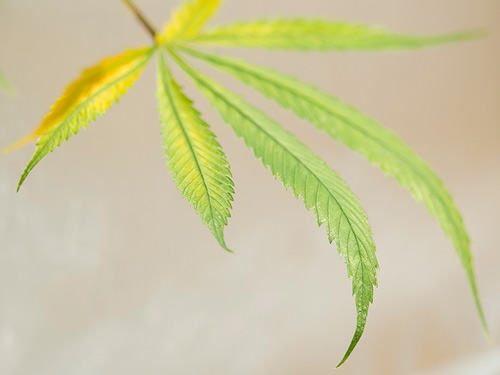
When growing weed outdoors in Western Europe, overheating is not a common occurrence, but due to climate change, it is possible that it will get hotter than a weed plant can handle for a week or month. In that case, you won't do much about it if the weed is also in the open ground. A potted weed plant can still be moved to a well-ventilated greenhouse or better yet, a conditioned grow room, but certainly not everyone will have that at their disposal.
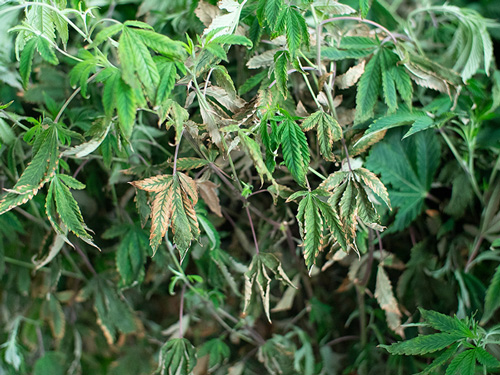
Too much nutrition: the reason that you should always follow a growing schedule is that a plant can not only be short of nutrition, but also surplus. When that happens, initially the pH of the soil and nutrient water changes. As a result, the plant can no longer absorb some nutrients at all and others very well. And that manifests itself visually in various leaf problems. But that's the least of your worries. What you don't see is that the tips of the roots "burn", causing them to die off and therefore no longer absorb water and nutrients. So, to sum up, follow the growing schedule as if it were a religious book.
Other possible causes of curly yellow leaves with brown tips
Root rot is also a possible cause. This occurs when growing in soil because excess water cannot drain. Then parasitic fungi get the chance to eat the roots. Root rot can also be recognized by soaking wet soil in combination with fungi on the top and leaves that feel heavy and hang limply. In a later stage, the roots can no longer absorb water and the plant dies. The leaves then hang just as limp, but are paper-like and irretrievably dried out. Furthermore, spider mite is also a possible cause of yellow and brown discoloration.
Spider mite in your weed plant
Probable cause
Spider mites
Continue to investigate and fix leaf problems
Recognizing spider mite: if you inspect your weed plant one day and you see all these fine threads running between buds and leaves, with little black, brown or red dots in them (depending on the light), then you have a spider mite infestation in the weed plant.
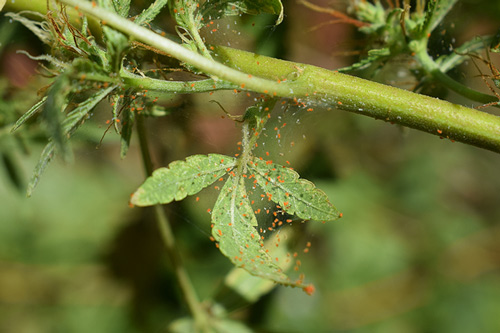
Fighting spider mites
A spider mite infestation is annoying. Nobody wants bugs in their vegetables! And a few critters can become a colony of hundreds within a few days, leaving your beautiful buds filled not only with these insects, but also with "cobwebs" that make your buds look like gray cotton candy. The sooner you can identify spider mites, the sooner and more effective the control. Use Spidermite Control as instructed and you'll be rid of it in no time.
Brown Spots on the Leaf of your weed Plant
Probable cause
Phosphorus deficiency. Other possible causes: calcium deficiency or leaf spot disease (downy mildew).
Continue to investigate and fix leaf problems
Phosphorus deficiency: if a weed plant is deficient in phosphorus, the lower leaves will be the first to turn dark green or yellow. The final discoloration can be a combination of factors. However, you will gradually see larger and larger brown, bronze or even blue spots on these bracts. With a phosphorus deficiency, the leaves may thicken, curl and feel stiff. In some cases, you may also get purple or red stems. More on that later.
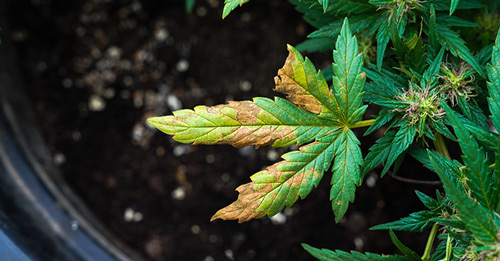
- A phosphorus deficiency occurs more often in the flowering phase than during growth, because weed plants consume more phosphorus as they form buds.
- Therefore, switch to proper plant nutrition during the flowering phase. Bloom nutrition contains more phosphorus compared to other elements for this reasons.
Other possible causes of brown spotting leaves
Calcium is one of the secondary nutrients in weed. A calcium deficiency is often accompanied by a phosphorus deficiency. Therefore, give proper plant nutrition and make sure the pH level is restored. Measure the pH level with an appropriate pH meter and adjust the pH if necessary with Calmag Pro, for example.
Purple stems or purple leaves
Probable cause
Cold weather. Other possible causes: phosphorus deficiency, humidity too low, root damage or pH too high.
Continue to investigate and fix leaf problems
Cold weather: some weed plants have the genetic predisposition to turn purple, red or blue when the weather gets colder. Purple Haze, Blueberry and Granddaddy Purple are known for this and are bought for this very reason. It also looks pretty cool in your garden, this purple weed plant. But might there be something wrong with the weed plant?
No, not if you can rule out a phosphorus deficiency (see the problem above) and if the pH value is OK. Cold weather or a cold temperature in your grow room should be avoided especially during growth and the first weeks of flowering.
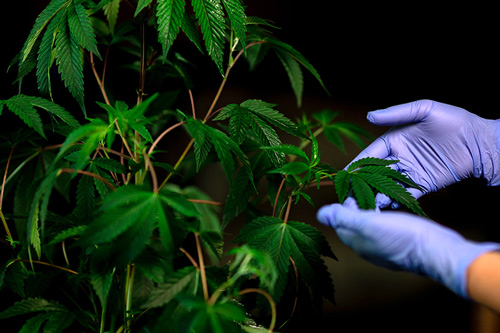
- Make sure the temperature does not get too low. Below 20 degrees, phosphorus does not transport as easily in the weed plant. You may give enough nutrition, but with a low temperature, that phosphorus will not reach the stems and eventually into the leaves. If the temperature drops below 17 degrees Celsius, the plant has a very difficult time. Phosphorus then hardly gets into the leaves, so the plant not only gets purple stems, but eventually brown spots in the leaves.
- The above should be taken with a grain of salt if the goal is to grow purple weed. But then, the strain you have must be predisposed to indeed turn purple. This is only meant to happen at the end of flowering. Technical story: then it's not the lack of phosphorus, but the withdrawal of leaf green (chlorophyll) due to colder nights, leaving red dyes (anthocyanins) in the leaves and giving your weed plant a beautiful color. These are the same substances that also give red cabbage and blueberries their color.
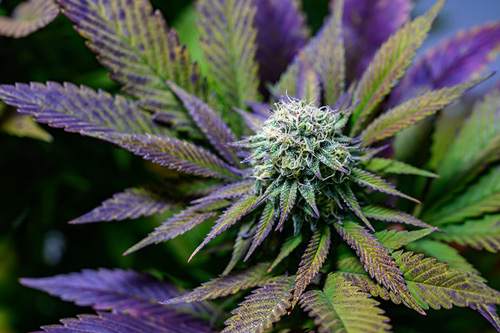
- Check that the humidity is correct. It should be as high as possible during growth and between 40 and 60 percent during flowering. If the humidity is too low, the plant can go into protection mode and purple stems will also appear.
- Is the pH level too high? Then you can easily make the soil more acidic with pH-min or Lemon Kick.
- Do you only have purple stalks, but nothing else is wrong? Then there is no problem.
Brown tips weed plant
Probable cause
Potassium deficiency.
Continue to investigate and fix leaf problems
Potassium deficiency: potassium deficiency, the third of the three main ingredients in plant nutrition, manifests itself in brown dots on the leaves, followed by yellow. The further along the stage, the browner the edges of the leaves become. Also, the plant may start to stretch. This means more space between branching and leaves, making the plant unnecessarily tall and therefore weak. Leaves can turn white, yellow or brown, but the leaf vein almost always remains green.
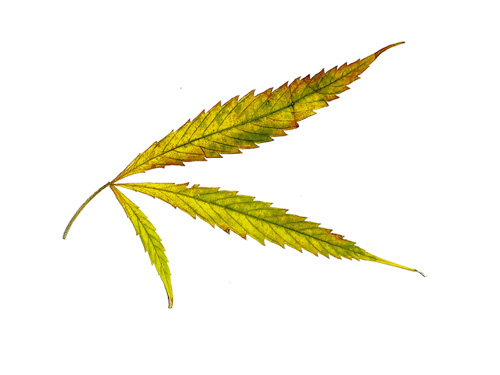
- Again, make sure you give your weed plant the right basic nutrition.
- It is natural to think that your plant is not getting enough water in this case, because the tips look like they have dried out. But giving more water will only make the problem worse.
- What you need to do is follow the growing schedule of the nutrition you give. Therefore, we link once more the three growing schedules of our plant nutrition brands:
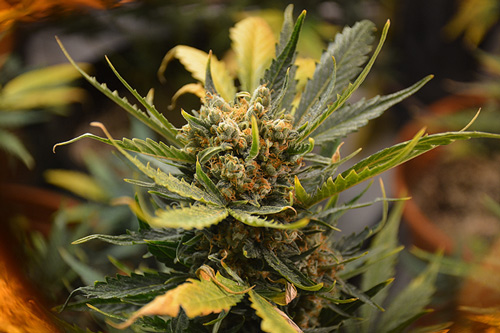
A brown edge here and there, a yellow leaf, but otherwise a beautiful bud in the week before harvest? Don't do too much about it!
Finally, does your plant look a little exhausted at the end of the flowering phase with any of the above leaf problems? Don't worry too much. If you've got a juicy bud on your hands and the time to harvest is coming, you'd do well to stop feeding. Stick to timely watering (flushing) and hold on that last week until the resin glands turn amber.